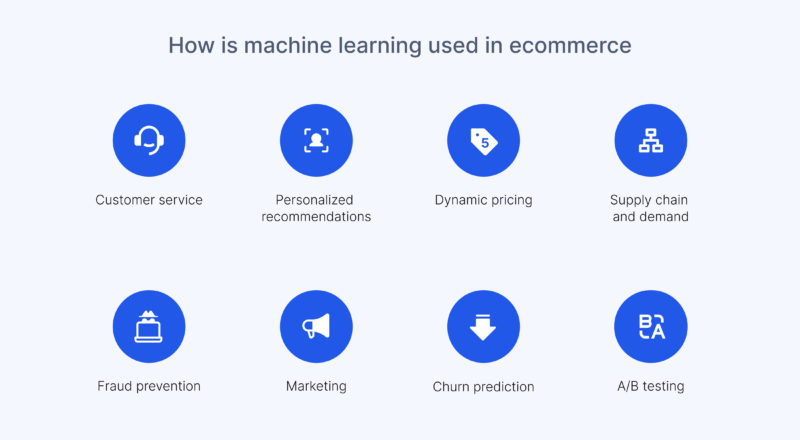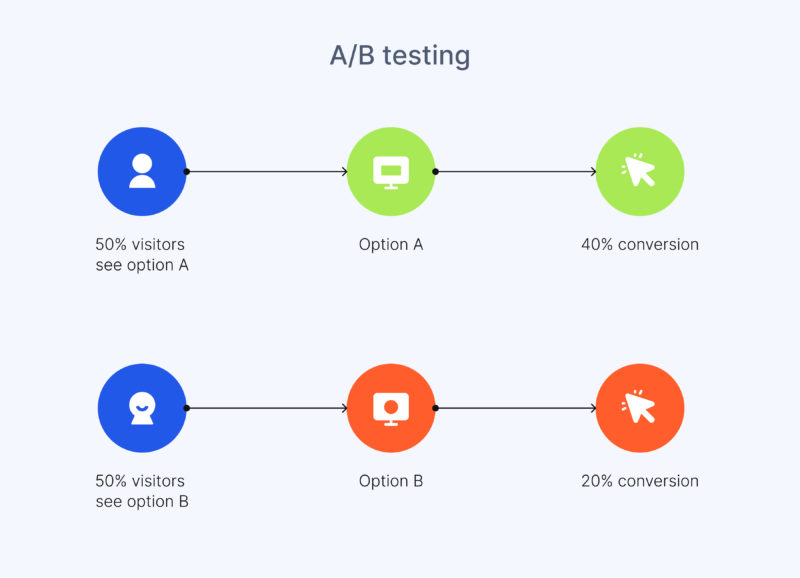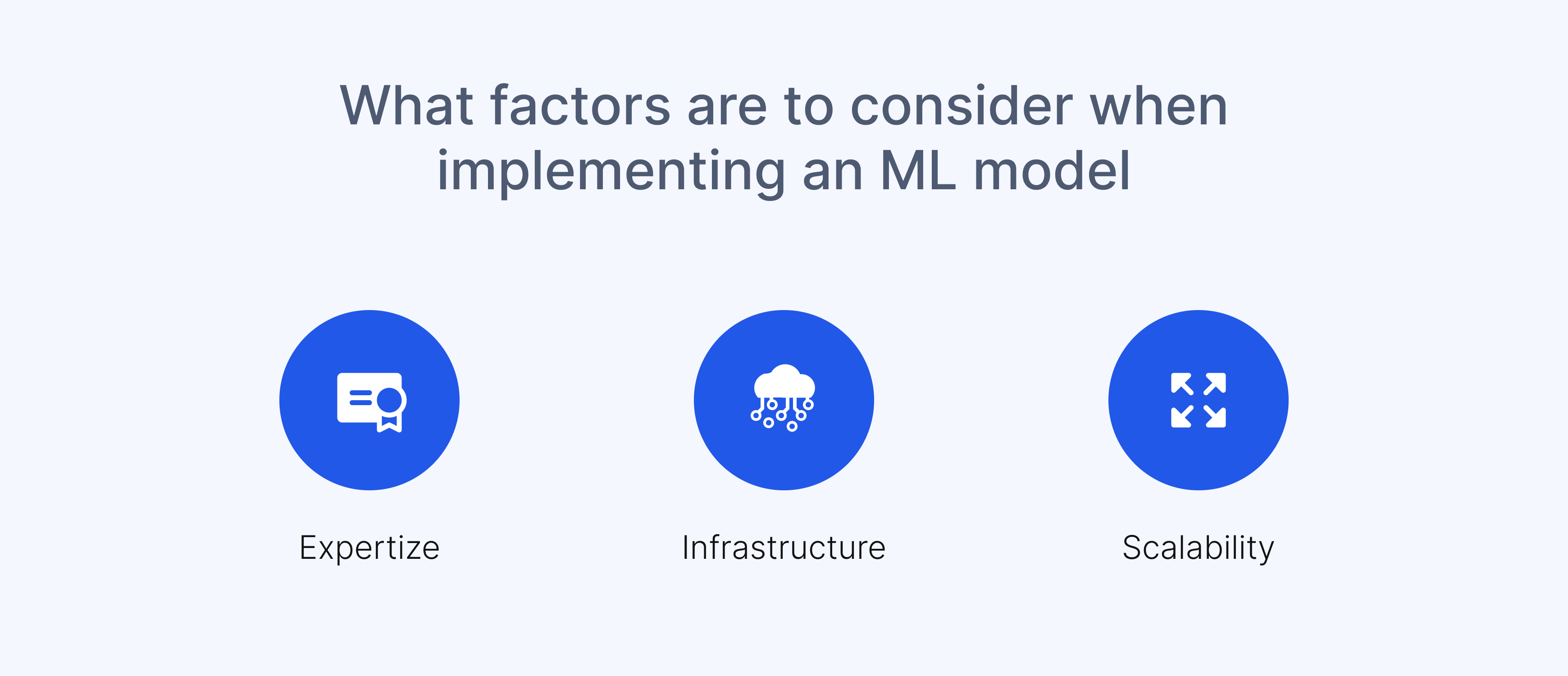
Contact us
Our team would love to hear from you.

Today, machine learning technology is helping ecommerce businesses in a variety of ways. Implementing ML solutions is no longer about trying something new or different — it’s about identifying new opportunities for your business. In this section, you will learn about the use cases of machine learning that can have a positive impact and change your business for the better.

For any business, positive customer experience is key to loyalty. However, to understand what creates a positive experience for online customers, data from various sources (e.g., social media, website, call centers, etc.) must be gathered and analyzed. ML solutions, with their exceptional ability to process and analyze huge amounts of data, can uncover every step of the customer journey and improve customer satisfaction in various ways.
A great way to improve customer service is by using chatbots. Chatbots analyze data in real time and create human-like conversations with users. The remarkable thing about chatbots is that the more they interact with customers, the better they understand the products or services offered by an ecommerce site. As they ask questions, chatbots uncover potential upsell opportunities and identify customers’ long-term needs.
A common application of ML-powered chatbots is customer support. It’s an efficient way to meet growing customer demand, largely because unlike humans, chatbots can provide accurate answers 24/7. One more ecommerce trend is using chatbots as personal shopping advisors. By asking a few questions, chatbots can predict customer needs and make suggestions. By using chatbot assistants, online stores offer customized shopping experiences.
Machine learning enables ecommerce businesses to achieve an unparalleled level of personalization, tailoring customer interactions to the preferences of individual shoppers. Data is collected from browsing history, interactions with the ecommerce platform (Shopify, Magento or etc.), social media accounts, etc., allowing ML algorithms to predict what products shoppers are likely to buy next. This approach increases the likelihood of future purchases. For example, ML in ecommerce can recommend products similar to those shoppers typically search for, or suggest discounted items to sales hunters.
As online shoppers become savvier, setting competitive prices is one of the most critical issues facing retailers. The old formula based on an annual analysis of costs, supply and demand, and competition no longer works. This is why owners of e-commerce platforms have adopted custom retail software and ML algorithms for dynamic pricing. Dynamic pricing is the strategy of flexibly adjusting prices based on current market conditions.
There are three methods of dynamic pricing:
With the help of ML solutions, e-commerce store owners can change prices in real time. Such precise calibration would be almost impossible without machine learning. Dynamic pricing allows companies to solve a wide range of problems, from maximizing profitability on units sold to entering a new market.
In the supply chain field, ML provides accurate inventory management which is an ongoing concern in e–commerce. Manual stock is not only time-consuming but also can not accurately predict sales volume, which can lead to disruption of financial flows. By using ML algorithms, ecommerce platform owners can consider both historical and real-time data to plan inventory and improve the accuracy of future demand predictions. ML models help monitor shifts in consumer demand and react to them quickly. It enables detecting excesses and shortages of assets to prevent sales losses.
In addition, this information can be used for targeted marketing and price adjustments.
Ecommerce fraud refers to illegal transactions that are performed on an e-commerce platform.
As the methods of fraud become more sophisticated, so are the methods of fraud detection and prevention. ML solutions help identify and prevent fraudulent behavior by analyzing historical data and detecting suspicious patterns. Based on these patterns, a set of rules assigns a risk score to every transaction. These rules will be applied to every transaction made via the e-commerce platform. These rules are selective, meaning different rules will be used for different cases. In addition, the more transactions the algorithm processes, the more precise it becomes. The crucial advantage of using ML in fraud detection is that all the processes are seamless and hidden from ecommerce platform users.
The data e-commerce platforms possess, can be fed to ML algorithms to identify the interests of different shoppers on a particular website. As a result, accurate customer segmentation can be performed — potential customers can be split based on their interests. Therefore, marketing materials can be precisely targeted to the prospects. Here are a few hints ML can do to help businesses make their email marketing campaigns more efficient:
In the context of ecommerce, churn rate means the number of customers that stop buying from a particular store. Customer churn rate is one of the most important indicators of customer satisfaction. Low churn rates mean loyal customers. It is critical for business to be aware of why and when customers are likely to leave as the costs of new clients acquisition is several times higher than the costs of retention. Traditionally, efforts were targeted to the new customer acquisition rather than retention. However, the importance of customer retention and its impact on increasing profits has become paramount. Machine learning is the best way to predict customer churn and retain customers.
By implementing an ML model for accurate churn prediction, businesses can build effective customer retention strategies and take measures to prevent customers from shopping with competitors or unsubscribing from a service.

A/B testing helps choose the best option between two things. Website A/B testing implies testing two versions of a website to find out which one will be suited to its users. In ecommerce, A/B tests aim to increase the conversion rate of the actions that are to be taken by site visitors. Following are some examples of how machine learning can facilitate implementation and usage of the A/B testing method.
Projects that involve ML solutions differ in terms of scale and complexity. However, their general strategy structure remains the same. Below, a scenario for implementation of an ML solution to predict customer churn is described.
The starting point is matching a problem with a potential solution. In our case, the customer churn rate is too high. The identification of high-risk customers can help find a solution that was not found before. For this reason, detection of customer behavior patterns based on the habits of those who have already left the company is key. With the help of these patterns that indicate decreasing customer dissatisfaction, proactive measures can be taken.
At this stage, a business analyst defines the frameworks of the future ML project and, together with a solution architect, checks their feasibility. The next project stages are closely connected with data. They are data collection, selection, preprocessing, and transformation.
The point of departure here is to acquire data to work with. It is a task for business analysts, to identify data sources that the future ML model can use (CRM, analytics services, feedbacks, etc.).
How much data is needed is a difficult question to answer: it is only possible to evaluate whether data is useful when the ML model is being trained, and the more data, the better. Since we are writing about customer churn prediction, supervised machine learning will be used. This means that data is to be labeled.
Next, selected data must be converted into a suitable format. It is important to ensure the quality of data (same logic of the data points, consistent data sets).
Data formatting and cleaning are integral parts of this preparatory stage. Since data that is collected from different sources is recorded in different formats, data scientists transform data into a unified form appropriate for machine learning.
The essential stage that comes next is feature engineering. It starts with data selection. Data selection is choosing data sets to solve a particular problem, e.g. detecting customers that are likely to leave your ecommerce store.
In addition, selecting data involves identifying attributes that need to be considered when building an ML model.
An important part of this stage is preparing input features or attributes that represent patterns of customer behavior. The ML model takes these features into account to predict outcomes. It is then recommended to reduce the number of attributes and leave the most representative ones. This process, called feature extraction, allows reducing irrelevant information. Previously extracted features are then revised to define subgroups that are most correlated with your goal — in our case — with customer churn. To define features, different methods can be used. However, the underlying principle of all methods is an explanation of how ML models for ecommerce made certain conclusions. Model interpretability is one of the most important issues to be solved at this stage.
Using previously selected features, customer segmentation is performed. There are customer categories based on customer age, needs, etc. Since customer behavior in the same category is more or less similar, the same behavior patterns can be applied to the customers within the category to train the ML model. Such segmentation helps increase the accuracy of predictions. However, this process is optional and can be skipped if not relevant.
After preparing data, selecting features, and segmenting customers, the next step is selecting the period within which the ML model will make its observations to learn and the prediction period, if used for prediction modeling. In other words, define a timeline that would be enough for both making a justified prediction and detecting issues such as churn.
The modeling and testing stage that comes next develops an ML model. To define which model makes accurate predictions, different ML algorithms are tested. As a rule, a baseline model is created, which is then used as a reference point to compare the accuracy of more advanced algorithms.
Deployment and monitoring are production and postproduction stages. One or several ML models can be incorporated into the existing system or implemented as a dedicated software program. An important consideration here is that incorporated ML models need continuous training and performance monitoring. The more often company data becomes outdated, the more frequently ML models need to be tested.
These are time- and resource-consuming processes but the highly skilled data specialists at EffectiveSoft can help you to accomplish this task.
Moving the ML model into a live environment is a process that potentially introduces new risks and issues. Following are some considerations to make sure things go smoothly.

Expertize. Typically, different specialists are in charge of developing and deploying ML models because of different skills and experience needed. The machine learning and development teams at EffectiveSoft with extensive experience in the ecommerce field can perform the complete cycle of work required for implementing an ML model on your e-commerce solution.
Infrastructure. A missing robust infrastructure can be an obstacle when deploying an ML model. The implementation process is significantly slowed down if the improvements are made after the model development is started. In addition, there is a risk that model is to be learned again because of new and unknown data. Therefore, it is important to take care of proper infrastructure at the very beginning of your ML project. Cloud solutions that enable quick provision, spin down, shut off, and turn on large-scale computer clusters without downtime are a natural fit for solutions with ML models. In addition, cloud solutions can scale quickly as ML models grow. Among the top providers offering cloud solutions to work with data are Google Cloud Platform, Microsoft Azure, and Amazon Web Services (AWS).
Scalability. It is important to remember that ML models grow over time. Future ML applications should be able to handle any amount of data and perform numerous computational operations in a cost-effective and time-saving manner.
Scalability also matters because most of the big players in e-commerce have already discovered the power of big data analytics augmented by machine learning and use these powerful technologies together. To take advantage of big data by using ML algorithms without loss of system performance, skilled data engineers like those at EffectiveSoft are ready to face the challenge and make ML pipelines scalable.
To facilitate development of ML models and their deployment into the production environment, CI/CD pipeline* can be embedded into the overall ecommerce software development life cycle. It ensures that changes are made quickly, consistently, and with minimal errors.
The use of CI/CD in ML deployment can bring many benefits to e-commerce companies, including faster iteration, reduced risk, and improved quality. With faster iteration, ecommerce companies can quickly test and deploy new ML models and see results in real time. This allows them to continuously improve their ML models. In addition, the use of CI/CD reduces the risk of errors because the pipeline automates many manual tasks, such as testing and deployment, that can lead to human error. Finally, the use of CI/CD in ML deployment increases the overall quality of ML models because the pipeline ensures that they are thoroughly tested and validated before they are deployed to production.
In addition to CI/CD, observability is another critical aspect of complex e-commerce solutions with ML implementation. Observability is the practice of monitoring and diagnosing the performance and behavior of a system, including its ML models. With observability, ecommerce companies can quickly identify and resolve any issues that arise in their ML models, ensuring that they perform as expected and deliver the desired results. This helps e-commerce companies maintain high levels of performance and customer satisfaction, and continuously improve their ML models over time.
Site Reliability Engineering (SRE) is also an important consideration for complex e-commerce solutions with ML implementations. SRE is a discipline that combines software engineering and operations to ensure that systems, including ML models, are reliable, scalable, and efficient. SRE practices, such as load testing, availability testing, and disaster recovery, help e-commerce companies ensure that their ML models can handle large amounts of traffic and data and recover quickly from any problems that may arise. By incorporating SRE into their ML deployment process, e-commerce companies can build robust and reliable ML models that meet the high demands of the e-commerce industry.
*Continuous integration (CI) and Continuous deployment (CD) is a set of practices and pipelines that automates the building, testing, and deployment process.
Machine learning is the future of ecommerce, and companies that adopt it will reap the benefits of increased efficiency, better customer experiences, and increased revenue. According to an article by Forbes, “Investing in machine learning will be the key to staying ahead of the curve in ecommerce and staying ahead of your competitors.” Don’t miss out on the opportunity to adopt machine learning in your e-commerce business today.
If you’re ready to take your ecommerce business to the next level, now is the time to start exploring the many ways that machine learning can help. Just contact us to discuss your project.
Our team would love to hear from you.
Fill out the form to receive a consultation and explore how we can assist you and your business.
What happens next?